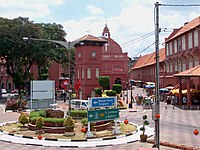
Photo from wikipedia
During last decades, the international community has become aware of the need to adapt to the effects of climate change, as the sensitivity of natural and human systems gained relevance.… Click to show full abstract
During last decades, the international community has become aware of the need to adapt to the effects of climate change, as the sensitivity of natural and human systems gained relevance. Europe is one of the most urbanized regions, accounting for a 73% of people living in urban areas. This share, together with the increase of urban land take, has concentrated the fight against climate change in cities, which are considered as one of the most vulnerable areas. European cities are characterised by a wide range of cultural heritage, which is commonly located in what is defined as the historic city. In order to protect urban heritage from a changing environment, emphasis should be given to the integration of conservation management and urban planning strategies, within wider goals of local sustainable development. Historic cities have a great potential in contributing to local economy and enhancing investment climate. Modern conservation strategies need to address a balance between urban growth and quality of life in a sustainable way. They should match the interrelationships of existing building stock, spatial organization, natural characteristics and social, cultural and economic values. Furthermore, the need to address a new generation of strategies, adapted to new climatic scenarios, should be considered as a priority for an effective management of the whole city. The proposed paper presents research results of the ADVICE project, based on a multiscale approach for the management of climate change impacts on cultural heritage located in the urban context. Vulnerability is addressed for different types of heritage, both at urban or building scale, considering their singularities as well as the context in which they are included. This will permit addressing the overall urban scale, together with data at structure level. Adaptive measures in general can be of a preventive character and improve resilience yet they can also offer preparative support when dealing with the anticipated effects of climate change and extreme events. In order to be effective, they need to be addressed according to the typology of object to be protected and to the scale of the impact or disaster they are facing. Vulnerability mapping is one of the first steps in clarifying the challenges which climate change pose for a city and its stakeholders. Assessment of climate change impacts and vulnerability vary widely, depending on the subject, time frame, geographic coverage and purpose of the assessment. KPIs are therefore needed to address the overall as well as the specific vulnerability and exposure for risk scoring, in order to propose effective adaptive measures.
Journal Title: Entrepreneurship and Sustainability Issues
Year Published: 2017
Link to full text (if available)
Share on Social Media: Sign Up to like & get
recommendations!